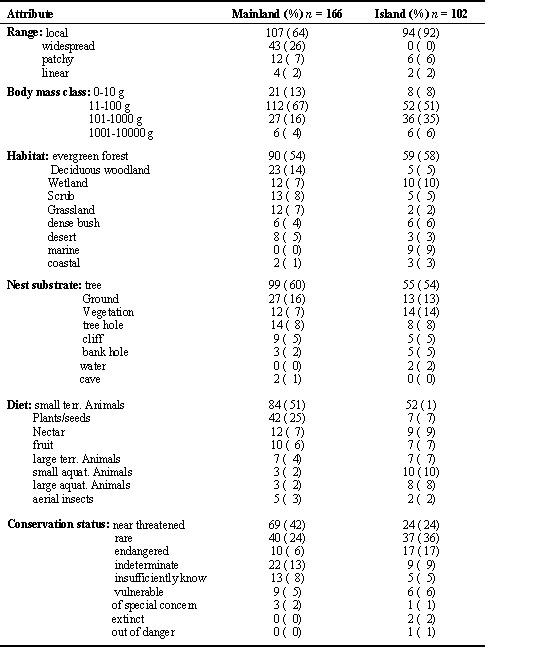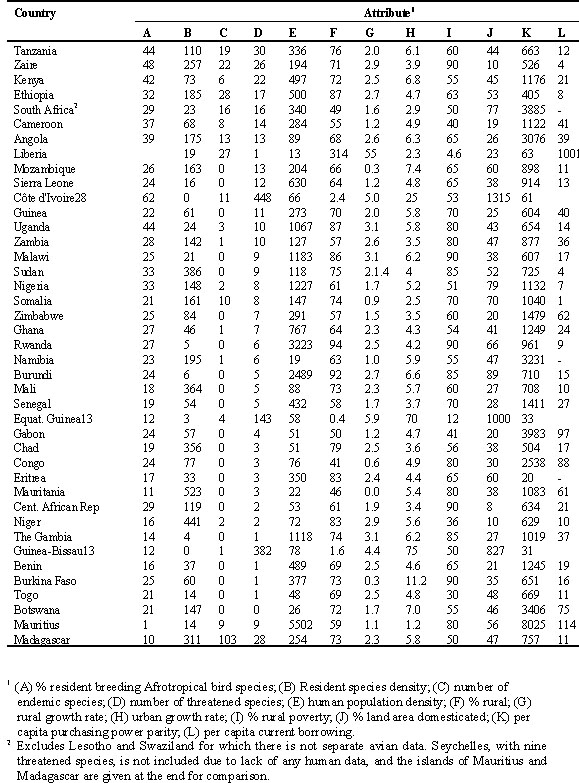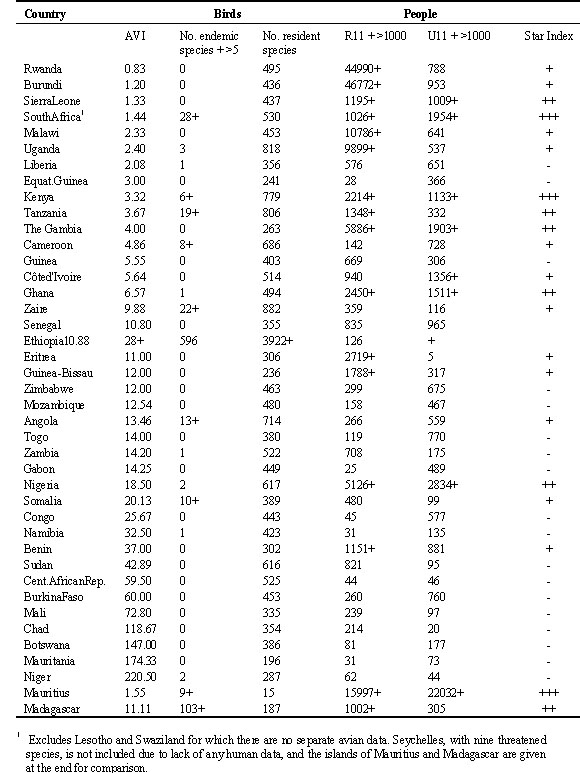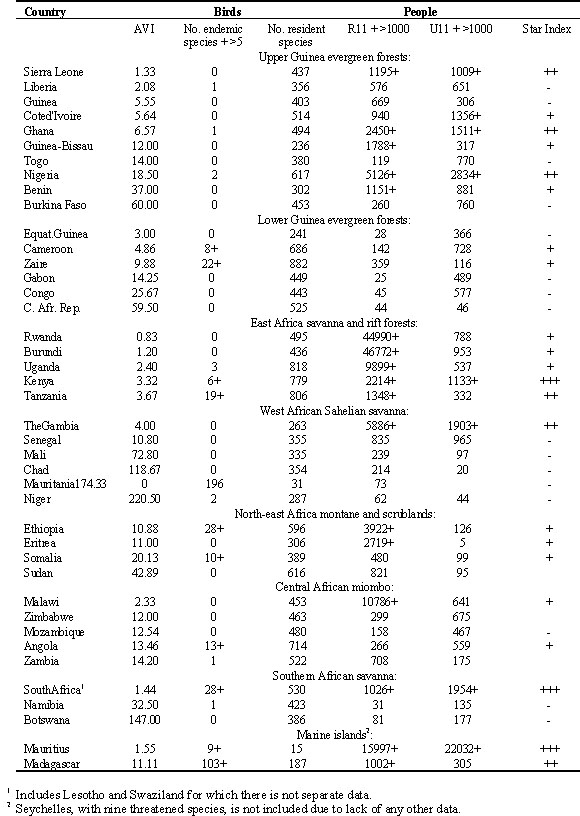
S27.1: Biological attributes predisposing Afrotropical birds to the threats of human-induced extinction
Alan C. Kemp
Department of Birds, Transvaal Museum, PO Box 413, 0001 Pretoria, South Africa, e-mail kemp@tm.up.ac.za
Kemp, A.C. 1999. Biological attributes predisposing Afrotropical birds to the threats of human-induced extinction. In: Adams, N.J. & Slotow, R.H. (eds) Proc. 22 Int. Ornithol. Congr., Durban: 1520-1527. Johannesburg: BirdLife South Africa.Prediction of the vulnerability of populations to extinction is important in understanding and planning conservation. Biological attributes of Afrotropical birds that are safe, vulnerable, threatened or extinct were compared. Analyses included species from islands adjacent to Africa and, where necessary, distinguished continental from insular species. Four main factors are positively related to the probability of extinction: range continuity, range size, population density and body size. These factors can operate independently or in tandem. Each factor is exacerbated by population fragmentation and its effects on metapopulation structure, but at different spatial scales. Effects of small range size and low population density are heightened if the species is a specialist rather than a generalist, and if its preferred habitat contains elements important to man. Vulnerability of large species will often be masked in the short term by their mobility and slow population turnover. Man-induced extinction will be most frequent in local populations, except for species whose ranges are already small or reduced.
INTRODUCTION
Conservation of biodiversity is first an issue concerning humans and only secondly an issue about animals and plants. If humans were not present on Earth there would be no biodiversity crisis, no need for conservation and no concern about extinction. This suggests that two separate sets of biological information are necessary to predict the fate of any population of organisms, in this case Afrotropical birds. First, one needs to analyse what biological factors might predispose bird species to decline under selection pressures induced by human activites. This is the traditional approach which has been widely applied, including to Afrotropical birds (Collar & Stuart 1985). Second, one needs to predict how future human development (biological, material, political, social) might affect those same species.
In this paper I attempt to analyse those biological attributes, both avian and human, which might predispose Afrotropical birds to human-induced extinction. I also attempt to derive a predictive capacity as to which groups of birds and which sub-Saharan African countries or regions might be of greatest conservation concern. Finally, I indicate those improvements in data that would improve our proactive capacity.
METHODS
Three main references were consulted to construct data bases about Afrotropical birds and humans. A contribution to the distribution and taxonomy of Afrotropical and Malagasy birds (Dowsett & Dowsett-Lemaire 1993) provided information, country by country, on which and how many bird species occur where. World resources 1996-97 (World Resources Institute 1996) provided information, also at the political unit of the country, on aspects of human reproductive biology and consumption. Threatened birds of Africa and related islands (Collar & Stuart 1985) listed and provided a specific African-based list on the biology and status on those bird species for which there is conservation concern. These are subsequently termed ‘at risk’ to avoid confusion with the specially defined IUCN categories of threat (vulnerable, threatened, endangered, etc.). A more recent assessment of African species ‘at risk’, their biology and their exact IUCN conservation status is available as part of a world-wide compilation (Collar et al. 1994).
The following biological attributes were recorded for each bird species considered ‘at risk’: (1) Main topographic features inhabited (islands, mountains, lowlands, watercourses), (2) Characteristics of geographical range and distribution (local, widespread, patchy, linear), (3) Mean body-mass class (<10 g, 11-100 g, 101-1000 g, >1000 g), (4) Main habitat preference (evergreen forest, deciduous woodland, dense bush, grassland, scrub, desert, wetland, coastal, marine), (5) Main nest substrate (tree, ground, vegetation, tree hole, cliff, bank hole, water, cave), (6) Main diet (plants/seeds, nectar, fruit, small terrestrial animals, large terrestrial animals, small aquatic animals, large aquatic animals, aerial arthropods) and (7) IUCN conservation status (out of danger, indeterminate, near-threatened, rare, vulnerable, endangered, of special concern, recently extinct).
The following avian information was also extracted for each sub-Saharan African country: (a) The percentage of resident African species, (b) The density of resident species per 10000 km2, using values standardised from a species-area curve (World Resources Institute 1996), (c) The number of endemic species, (d) The number of ‘at risk’ species.
Human statistics extracted for these same countries included: (i) Population density in 1995, (ii) Percentages of the population living in 1995 in urban and rural conditions, (iii) The 1900-95 growth rates of the urban and rural populations, (iv) The percentage of rural people living in 1980-90 in absolute poverty, (v) The percentage of the total land area domesticated by 1995, being the sum of croplands and permanent pastures, (vi) The 1993 per capita International Purchasing Power Parity in US$, as derived from the Gross Domestic Product and (vii) The 1991-93 per capita current borrowing in US$.
I used these data to derive three indices for country-by-country comparisons. The Avifaunal Vulnerability Index (AVI) was the avian density (b) divided by the number of ‘at risk’ species (d). This assumed that birds in countries with high densities of avian species and high numbers of threatened species were most vulnerable and showed the smallest AVI. The Rural Impact Index (RII) was the human population density (i) times % rural (ii) times rate of rural increase (iii) times % rural poverty (iv) times % domesticated land (v). This assumed that rural populations would have the major impact on remaining avian habitats, which will be exacerbated by a high rate of increase in rural populations, a high rural poverty and a high proportion of land already domesticated. The Urban Impact Index (UII) was the human population density (i) times % urban (ii) times rate of urban increase (iii) times (per capita purchasing power (iv) plus per capita borrowing (v)). This assumed that urban populations place demands on rural habitats in proportion to their size, rate of growth, monetary affluence and debt commitments.
RESULTS
At least 268 bird species that breed in the Afrotropical Region were considered to be ‘at risk’ and therefore of conservation concern (Collar & Stuart 1985). This comprises 14.5% of a breeding fauna of 1842 species, out of a grand total of 2176 species recorded for the Region (Dowsett & Dowsett-Lemaire 1993). With regard to topography, more than one third of the species ‘at risk’ occur on islands (102, 38%), mainly on Madagascar, Mauritius and the Seychelles. Of the 166 (62%) mainland species, 73 (44%) favour montane terrain, 76 (46%) lowland terrain, and 17 (10%) occur along watercourses (rivers, swamps). Further biological attributes for all species were then analysed separately for continental and island species (Table 1).
When comparing mainland and island species, almost two-thirds of mainland species have locally restricted ranges as do, for obvious reasons, virtually all island species. More very small to small birds (<100g) were ‘at risk’ on the mainland and more medium-sized species (101-1000 g) on islands. Most species occur in evergreen forest on both the mainland and islands, but more species were ‘at risk’ in deciduous woodland on the mainland and in wetlands on islands. There were no obvious differences in nest substrate, except more island species used dense vegetation. More mainland birds ate plants and seeds and more island birds ate aquatic animals. In subjective conservation categories, more mainland birds are near-threatened or indeterminate and more island birds are rare or endangered.
Aspects of human biology that might affect the conservation status for an avifauna were extracted by country, in the order of the number of species ‘at risk’ (Table 2). There was no obvious correlation between any avian and human statistics. The three indices for each country were then compared (Table 3), the AVI, RII and UII. Countries were sorted by their AVI, and high scores for endemism (over five species), RII and/or UII (over 1000) were marked to generate a rough index.
While there was no exact correlation, when countries were listed by their AVI (Table 3), there was a trend for countries with high AVI to also have either high species endemicity, high RII, high UII or a combination of two or three high values. However, when the countries were sorted by major vegetation and climatic regions (Table 4), some regions had much higher scores per country than others, in particular the Upper Guinea evergreen forests, East African savanna and Rift forests and marine islands.
DISCUSSION
It is quite easy to study the conservation problems of a single species considered to be ‘at risk’, and then to relate these problems to past human-related changes in its environment (Collar & Stuart 1985, Collar et al.). It is less easy to score the attributes of all species that are known to be of conservation concern (Table 1), and then to make meaningful comparisons and look for trends or indicators in these data. It is most difficult to predict, from these results, what other species and areas are most likely to experience conservation problems in future. One reason for this difficulty is the lack of comparative data and analyses for the majority of 'safe' species.
This study (Table 1) indicates that species most ‘at risk’ have localised distributions, either on islands or on restricted mainland habitats such as montane forest. This is presumably because a small area of distribution can be more easily affected in its entirety, and because small areas of habitat support relatively small total population sizes. This might also be linked to why island species ‘at risk’ tend to be larger than mainland species, since larger species can be expected to occur at lower densities and therefore islands will support relatively smaller populations. Species most ‘at risk’ also appear to be those that occupy woody vegetation, especially evergreen forests and deciduous woodland, presumably because such habitats are most attractive for and easily, severely and permanently affected by human subsistence activities. Other correlations with the biology of species already known to be ‘at risk’ have less predictive value, probably through being less well defined or only applying to a few species.
There is also a trend for avifaunas to be most ‘at risk’ in countries with a high AVI, especially if they also have a high rural and/or urban impact index (RII and/or UII, Table 3). Such observations are simplistic and of little use in deciding exactly which species are most likely to become ‘at risk’, but they do indicate that predictions may be possible. For example, sorting the countries into major vegetation regions seems to improve the predictability (Table 4). It also highlights countries with unusual human population dynamics for a region, such as South Africa within southern Africa or The Gambia within West Africa. However, I think it unlikely that our predictive ability will improve until alternative data sets are compiled.
There appear to be two major problems with the data currently available. First, a species which has 100% of its range within one country is singled out and reported preferentially as an endemic species. However, those species whose ranges extend across several countries are scored as present for each country, but without any indication of what proportion of their range (or population) is represented per country, even though this could be anything from 1-99% of their total range. If the AVI for each country included avian data that was weighted for each species by the percentage of its range which occurs in that country, then it would be much more informative. If the percentage area could be further advanced to indicate the proportion of the population, using some index of relative abundance, as indicated for the southern Africa bird atlas (Harrison et al. 1997), then it would be even more informative.
Second, indices of human pressure on the habitats of species are only available at the scale of the country. This gives no indication as to whether the national average is applicable to, for example, the montane forests within a country. Such national indices are likely to be least accurate for large countries with diverse habitats, for example South Africa where one side of the country is arid and sparsely populated and the other is mesic and densely populated. This factor is considered more of a problem than the first one, since although adjacent countries cluster well according to their AVI, they often have quite disparate RII and UII. It is not clear whether it will be possible to generate the data necessary to calculate improved RII or UII, using figures for regional or habitat-related sectors that are not demarcated by political boundaries.
ACKNOWLEGEMENTS
David Allan and Leon Bennun invited me to deliver this paper and assisted with ideas and encouragement during its development. Richard Dean, Martin Whiting and my other colleagues at the Transvaal Museum provided useful discussion.
REFERENCES
Collar, N.J. & Stuart, S.N. 1985. Threatened birds of Africa and related islands. The ICBP/IUCN Red Data Book, Part 1 (3rd edn). International Council for Bird Preservation and International Union for Conservation of Nature and Natural Resources, Cambridge, U. K.
Collar, N.J., Crosby, M.J. & Stattersfield, A.J. 1994. Birds to watch 2. The world list of threatened birds. Birdlife International, Cambridge, UK.
Dowsett, R.J. & Dowsett-Lemaire, F. (eds) 1993. A contribution to the distribution and taxonomy of Afrotropical and Malagasy birds. Tauraco Research Report 5. Tauraco Press, Jupille, Belgium.
Harrison, J.A., Allan, D.G., Underhill, L.G., Herremans, M., Tree, A.J., Parker, V. & Brown, C.J. (eds) 1997. The atlas of southern African birds. Birdlife South Africa, Johannesburg.
World Resources Institute. 1996. World Resources 1996-97. Oxford University Press, Oxford, UK.
Table 1. Broad biological attributes and conservation status of 268 bird species considered ‘at risk’ in the Afrotropical Region, divided between mainland (62%) and island (38%) species.

Table 2. Afrotropical country comparison of avifaunal details with indices of human biology, sorted on species under threat (D).

Table 3. Comparison by Afrotropical country of levels of threat and levels of rural and urban pressure. See methods for indices AVI, RII and UII.

Table 4. Comparison by Afrotropical region and country of levels of threat and levels of rural and urban pressure. See methods for indices AVI, RII and UII.
